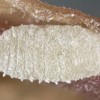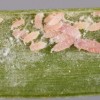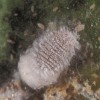 Florida Department of Agriculture and Consumer Services, Division of Plant Industry inspector Lisa Hassell collected the mealybug Phenacoccus multicerarii, a new continental record, from a retail nursery in Fernandina Beach (Nassau County, on 15 June 2011). On a return visit to the store, the mealybug was observed in high numbers on numerous host plants. Three days later, an additional find was made at a nursery in Apopka that had exchanged plant material with the nursery in Jacksonville. No further infestations were reported until October 2012, when a heavy infestation was discovered on a residential planting of coleus in Cooper City (Broward County). This mealybug was described in 2007 from a sample collected in Caracas, Venezuela, in 1949 from an unknown host (Granara de Willink and Szumik 2007). This 2-page fact sheet was written by Ian Stocks, and published by the UF Department of Entomology and Nematology, April 2013.
Florida Department of Agriculture and Consumer Services, Division of Plant Industry inspector Lisa Hassell collected the mealybug Phenacoccus multicerarii, a new continental record, from a retail nursery in Fernandina Beach (Nassau County, on 15 June 2011). On a return visit to the store, the mealybug was observed in high numbers on numerous host plants. Three days later, an additional find was made at a nursery in Apopka that had exchanged plant material with the nursery in Jacksonville. No further infestations were reported until October 2012, when a heavy infestation was discovered on a residential planting of coleus in Cooper City (Broward County). This mealybug was described in 2007 from a sample collected in Caracas, Venezuela, in 1949 from an unknown host (Granara de Willink and Szumik 2007). This 2-page fact sheet was written by Ian Stocks, and published by the UF Department of Entomology and Nematology, April 2013.
http://edis.ifas.ufl.edu/in993
Tag: Family: Pseudococcidae (mealybugs)
Mealybug Vryburgia trionymoides (DeLotto) (Pseudococcidae) (EENY553/IN991)
 On several occasions in 2011, succulents for sale at retail stores in Florida were found with infestations of the mealybug Vryburgia trionymoides DeLotto. A traceback revealed that the succulents originated in California, where this mealybug is known as an occasional greenhouse pest. Specimens intercepted or found in retail stores often were well-hidden in the axillary region near the stem, making detection more challenging. An untreated infestation can kill a plant, there are no published reports of economic losses caused by this species. This 2-page fact sheet was written by Ian Stocks, and published by the UF Department of Entomology and Nematology, April 2013.
On several occasions in 2011, succulents for sale at retail stores in Florida were found with infestations of the mealybug Vryburgia trionymoides DeLotto. A traceback revealed that the succulents originated in California, where this mealybug is known as an occasional greenhouse pest. Specimens intercepted or found in retail stores often were well-hidden in the axillary region near the stem, making detection more challenging. An untreated infestation can kill a plant, there are no published reports of economic losses caused by this species. This 2-page fact sheet was written by Ian Stocks, and published by the UF Department of Entomology and Nematology, April 2013.
http://edis.ifas.ufl.edu/in991
Tuttle mealybug Brevennia rehi (Pseudococcidae) (EENY551/IN989)
 The Tuttle mealybug, Brevennia rehi (Lindinger), is a pest of many grass species and occurs nearly worldwide, especially where rice and sugarcane are grown. Because Bermuda and zoysia are important lawn grasses, especially in the southern United States, infestation by Tuttle mealybug should be considered whenever dieback is noticed, especially if the grass blades show white wax or are sticky from honeydew secretion. Both Bermuda and zoysia lawns are commonly installed as sod or plugs, which provide a ready route for the spread of infestations should the pest control practices of the grower fail to maintain a pest-free production environment. This 3-page fact sheet was written by Ian Stocks, and published by the UF Department of Entomology and Nematology, April 2013.
The Tuttle mealybug, Brevennia rehi (Lindinger), is a pest of many grass species and occurs nearly worldwide, especially where rice and sugarcane are grown. Because Bermuda and zoysia are important lawn grasses, especially in the southern United States, infestation by Tuttle mealybug should be considered whenever dieback is noticed, especially if the grass blades show white wax or are sticky from honeydew secretion. Both Bermuda and zoysia lawns are commonly installed as sod or plugs, which provide a ready route for the spread of infestations should the pest control practices of the grower fail to maintain a pest-free production environment. This 3-page fact sheet was written by Ian Stocks, and published by the UF Department of Entomology and Nematology, April 2013.
http://edis.ifas.ufl.edu/in989
Citrus Mealybug Planococcus citri (Risso) (Insecta: Hemiptera: Pseudococcidae) (EENY537/IN947)
 The citrus mealybug is a common pest of citrus primarily in greenhouses, and of several ornamental plants in Florida. It has been recognized as a difficult to control pest in Europe since 1813, where it is called the greenhouse mealybug and in the United States since 1879. This 4-page fact sheet was written by Harsimran Kaur Gill, Gaurav Goyal, and Jennifer Gillett-Kaufman, and published by the UF Department of Entomology and Nematology, September 2012.
The citrus mealybug is a common pest of citrus primarily in greenhouses, and of several ornamental plants in Florida. It has been recognized as a difficult to control pest in Europe since 1813, where it is called the greenhouse mealybug and in the United States since 1879. This 4-page fact sheet was written by Harsimran Kaur Gill, Gaurav Goyal, and Jennifer Gillett-Kaufman, and published by the UF Department of Entomology and Nematology, September 2012.
http://edis.ifas.ufl.edu/in947
Passionvine Mealybug, Planococcus minor (Maskell) (Hemiptera: Pseudococcidae) (ENY920/IN920)
 The passionvine mealybug was discovered in the continental U.S. for the first time in southern Florida a little over a year ago. USDA, APHIS lists it as a high priority threat. Given its polyphagous nature, this pest should be given careful attention in a new area such as Florida, which has an important agricultural sector and amenable climate. This 6-page fact sheet was written by Antonio W. Francis, Moses T. K. Kairo and Amy L. Roda, and published by the UF Department of Entomology and Nematology, February 2012.
The passionvine mealybug was discovered in the continental U.S. for the first time in southern Florida a little over a year ago. USDA, APHIS lists it as a high priority threat. Given its polyphagous nature, this pest should be given careful attention in a new area such as Florida, which has an important agricultural sector and amenable climate. This 6-page fact sheet was written by Antonio W. Francis, Moses T. K. Kairo and Amy L. Roda, and published by the UF Department of Entomology and Nematology, February 2012.
http://edis.ifas.ufl.edu/in920
EENY459/IN827 Hypogeococcus pungens Granara de Willink (Insecta: Hemiptera: Pseudococcidae), a Mealybug
EENY-459, a 5-page illustrated fact sheet by Amanda Hodges and Greg Hodges, is part of the Featured Creatures collection. It describes this pink-colored mealybug that is sometimes confused with the pink hibiscus mealybug — synonymy, distribution, identification characteristics, life cycle, hosts, economic importance, and management. Includes references. Published by the UF Department of Entomology and Nematology, June 2009.
http://edis.ifas.ufl.edu/IN827
EENY459/IN827 Hypogeococcus pungens Granara de Willink (Insecta: Hemiptera: Pseudococcidae), a Mealybug1
EENY-459, a 5-page illustrated fact sheet by Amanda Hodges and Greg Hodges, is part of the Featured Creatures collection. It describes this mealybug native to South America which is sometimes confused with pink hibiscus mealybug, but has far fewer potential hosts — its synonymy, distribution, identification characteristics, life cycle, hosts, economic importance, and management. Includes references. Published by the UF Department of Entomology and Nematology, June 2009.
http://edis.ifas.ufl.edu/IN827
EENY448/IN815 Coconut mealybug Nipaecoccus nipae (Maskell)(Insecta: Hemiptera: Pseudococcidae)
EENY-448, a 5-page illustrated fact sheet by Adriana Espinosa, Amanda Hodges, Greg Hodges, and Catharine Mannion, is part of the Featured Creatures collection. It describes this widely distributed pest with a wide host range, that may be economically damaging to palms and tropical fruit crops — its distribution, field characteristics, life cycle, hosts, general plant damage and management. Includes references. Published by the UF Department of Entomology and Nematology, June 2009.
http://edis.ifas.ufl.edu/IN815